Swallowtails are the acrobats of the butterfly world, with their bold colors and elegant tails making them a sight to behold. These large, flashy butterflies are not just beautiful—they're performers, gliding and fluttering with grace. In this article, we'll dive into the world of North American swallowtails, exploring their striking looks, fascinating behaviors, and the plants they can't live without.
Eastern Tiger Swallowtail (Papilio glaucus)
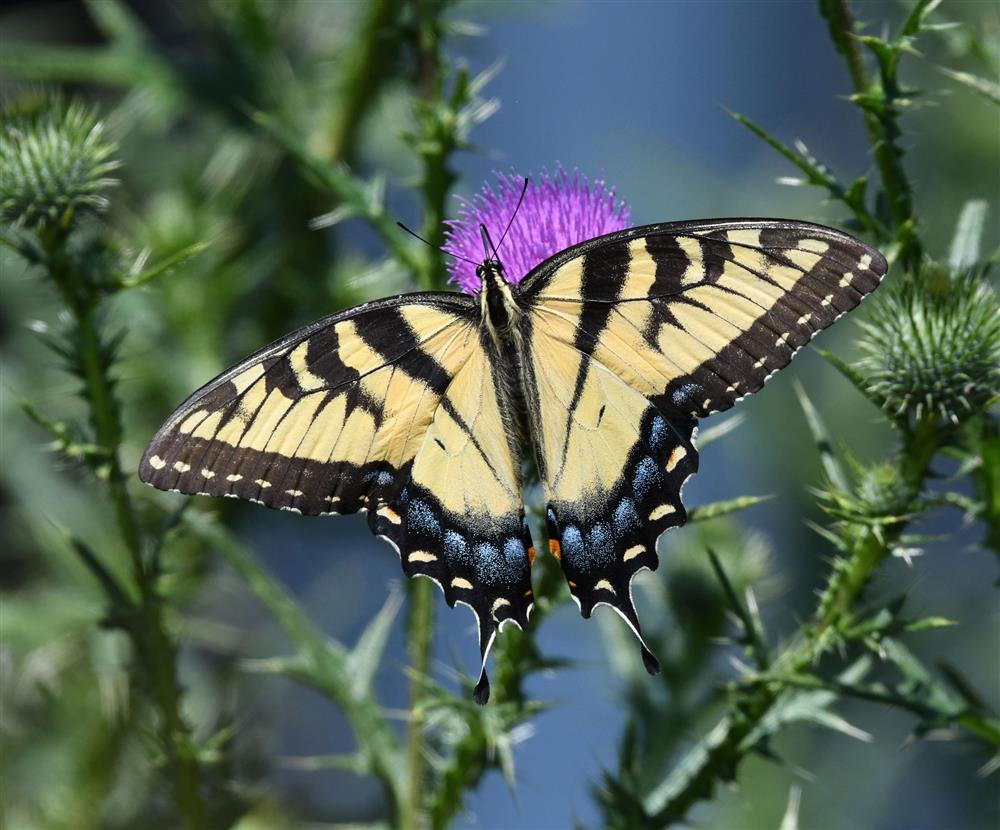
- Boys vs. Girls: The fellas are decked out in bright yellow with black stripes—think tiger but in butterfly form. The ladies? They've got options. They can either rock the yellow or go full-on goth with a dark, almost black look, mimicking their toxic cousin, the Pipevine Swallowtail, to keep the predators at bay.
- Home Turf: You'll find these beauties flapping around the eastern U.S., from the Northeast all the way down to Florida and as far west as the Great Plains.
- Favorite Fuel: They're not picky eaters—anything from wild cherry to milkweed will do. Lilac and Joe-Pye weed are also on the menu.
- Egg Drop Spot: The ladies lay their eggs on tulip trees, wild cherry, and sweet bay. Yep, these trees do double duty.
- Caterpillar Chow: The little ones munch on the same trees—tulip, black cherry, aspens, and sweet bay leaves are their go-to snacks.
- Behavior: Eastern Tigers are known for their "puddling" behavior, where males gather in groups on damp soil or sand to extract minerals. They're also skilled at thermal soaring, using warm air currents to glide with minimal wing-flapping.
- Habitat: Moist wooded areas
- Flight Period:
- South: March–November (3 broods)
- North: June–July (1 brood)
- Winter Stage: Pupa
Black Swallowtail (Papilio polyxenes)
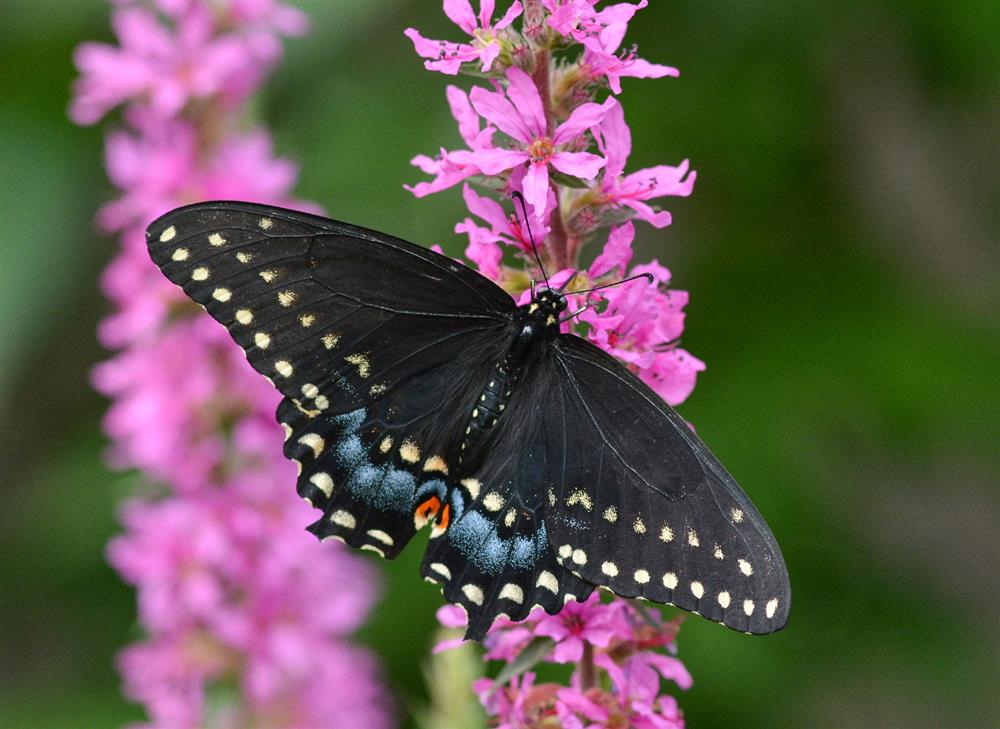
- Boys vs. Girls: Guys flaunt bright yellow spots, while the gals go a bit more subtle, with larger bodies and a soft blue shimmer on their hind wings.
- Home Turf: They're widespread, from southern Canada down to northern Mexico, but especially abundant in the eastern and central U.S.
- Favorite Fuel: Milkweed, thistles, clover—you name it, they'll sip it.
- Egg Drop Spot: The carrot family is where it's at—think parsley, dill, fennel, and Queen Anne's lace.
- Caterpillar Chow: The larvae stick to the script, chomping on parsley, dill, fennel, and Queen Anne's lace.
- Behavior: Black Swallowtails are master mimics. Their caterpillars resemble bird droppings when young, then switch to a green and black striped pattern with yellow spots, mimicking toxic caterpillars. Adults engage in a behavior called "flutter-diving" to lay eggs, rapidly descending to host plants.
- Habitat: Open areas
- Flight Period:
- South: March–November (3 broods)
- North: May–September (2 broods)
- Winter Stage: Pupa
Pipevine Swallowtail (Battus philenor)
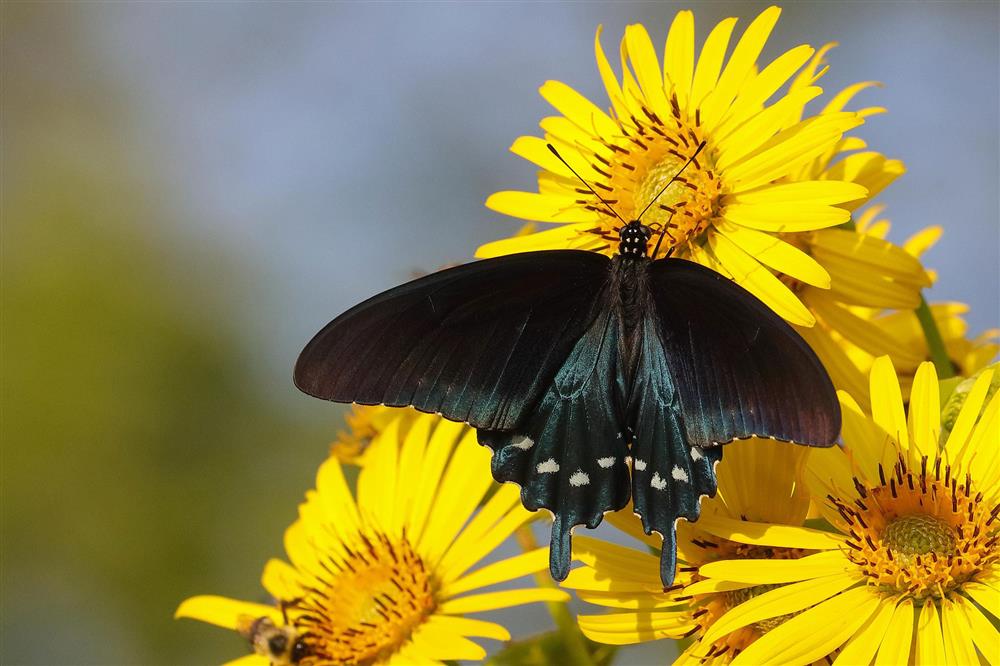
- Boys vs. Girls: The dudes are a dazzling iridescent blue, while the ladies keep it cool with a darker shade, still sporting some blue but not as flashy.
- Home Turf: Spanning the southern U.S., from the East Coast to California, and they've got a soft spot for the Midwest too.
- Favorite Fuel: Thistles, lantana, phlox—these guys love a colorful buffet.
- Egg Drop Spot: The name says it all—pipevines are the chosen nursery. They're toxic, but that's exactly why the larvae love them.
- Caterpillar Chow: Strictly pipevines. It's a toxic love affair that keeps predators away.
- Behavior: These butterflies are known for their slow, leisurely flight. They're also chemical defenders - both caterpillars and adults sequester toxic compounds from their host plants, making them unpalatable to predators. They often fly low to the ground, displaying their warning coloration.
- Habitat: Woods, open brush
- Flight Period:
- South: February–November (4 broods)
- North: April–September (2 broods)
- Winter Stage: Pupa
Spicebush Swallowtail (Papilio troilus)
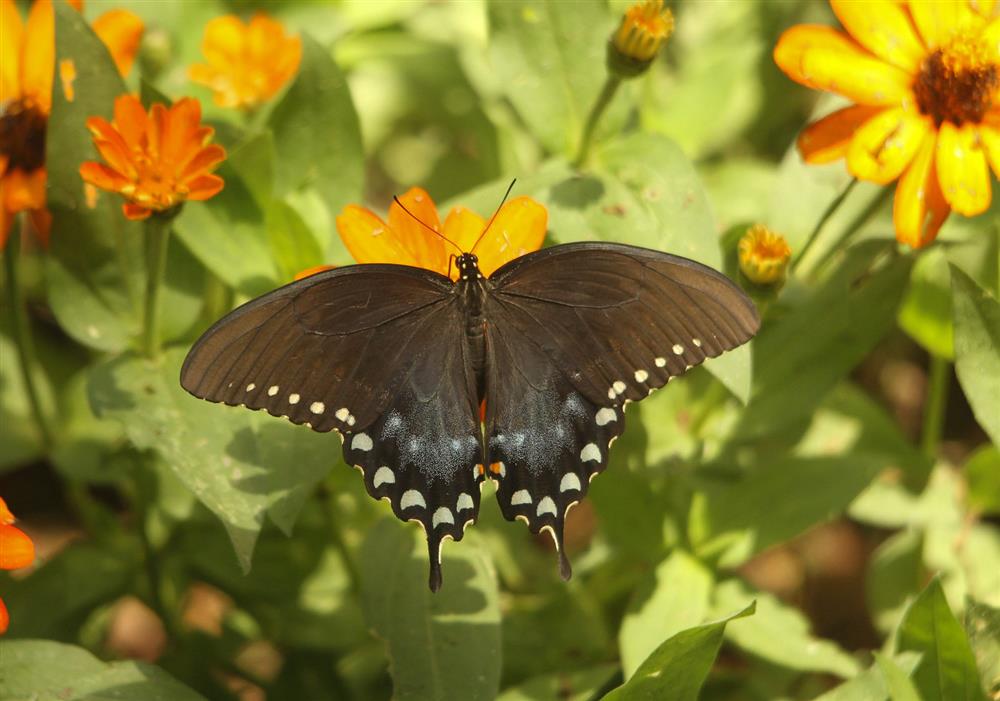
- Boys vs. Girls: Pretty similar, but the girls add more blue flair on their wings, while the guys go greenish.
- Home Turf: East Coast is their playground, from New England to Florida, stretching out west to Texas.
- Favorite Fuel: Honeysuckle, milkweed, lantana—these guys have a sweet tooth for wildflowers.
- Egg Drop Spot: It's all about spicebush and sassafras. If it's aromatic, it's a prime spot.
- Caterpillar Chow: The larvae dig into the leaves of spicebush and sassafras, filling up on those flavorful greens.
- Behavior: Spicebush caterpillars are excellent architects. They fold leaves over themselves, creating a shelter that protects them while they feed. Adult males are territorial, often chasing other butterflies and even small birds away from their preferred areas.
- Habitat: Woods, brush
- Flight Period:
- South: April–October (3 broods)
- North: May–September (2 broods)
- Winter Stage: Pupa
Zebra Swallowtail (Eurytides marcellus)
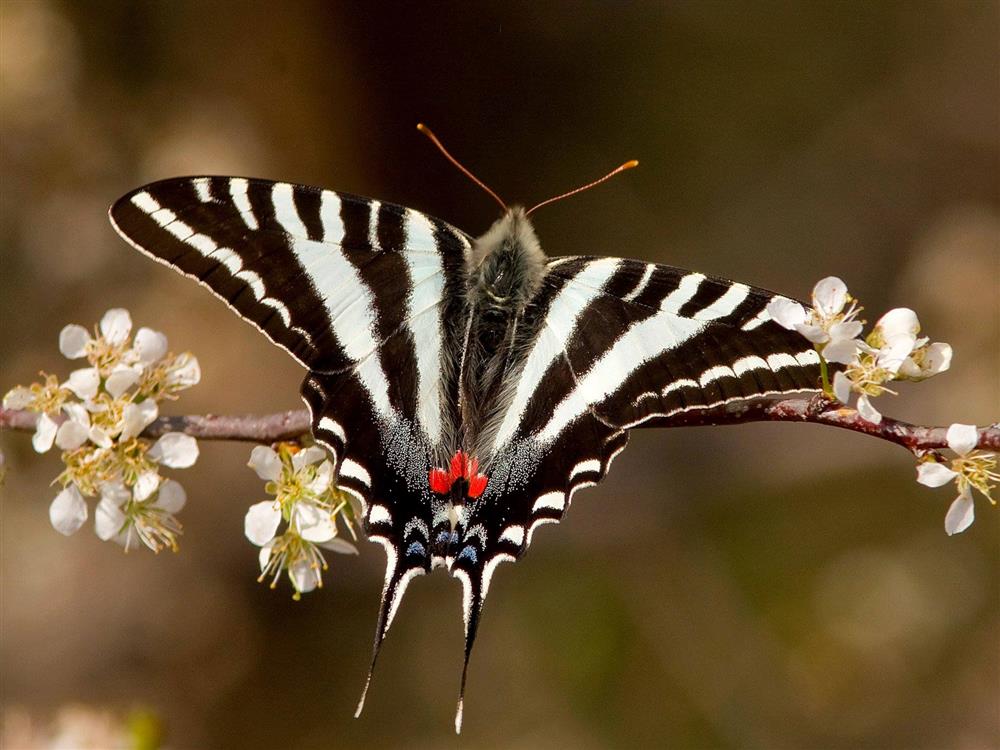
- Boys vs. Girls: Black and white stripes with long tails—fashion-forward for both genders. Males are just a tad smaller and sleeker.
- Home Turf: Mainly chilling in the eastern U.S., from the Great Lakes down to Florida, and as far west as Texas.
- Favorite Fuel: They hit up verbena, milkweed, and dogbane for a nectar fix.
- Egg Drop Spot: Pawpaw trees are the one and only choice. If you're a pawpaw, you're in luck.
- Caterpillar Chow: Larvae snack exclusively on pawpaw leaves, which pack a punch that makes them unappetizing to any would-be predators.
- Behavior: Zebra Swallowtails have one of the fastest flight speeds among North American butterflies. They're also known for their "tailing" behavior - their long tails move independently of their wings, confusing predators about which end is the head.
- Habitat: Open, moist woods
- Flight Period:
- South: February–December (4 broods)
- North: May–August (1 brood)
- Winter Stage: Pupa
Giant Swallowtail (Papilio cresphontes)
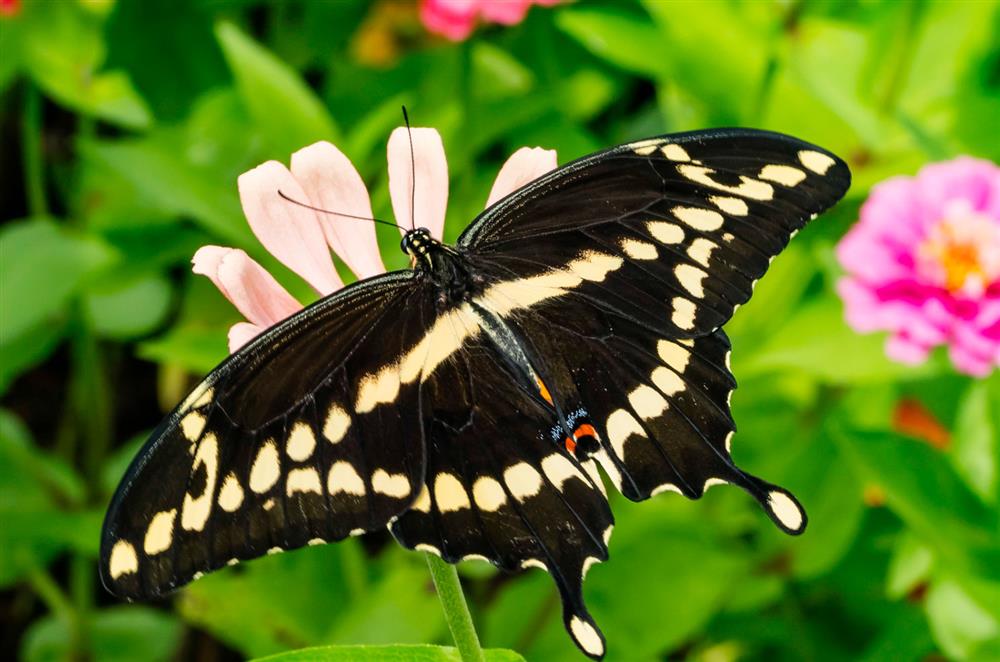
- Boys vs. Girls: Both are rocking big black wings with yellow bands. The girls are larger and built for power.
- Home Turf: The southern U.S. is their base, but they're not afraid to venture north into Canada.
- Favorite Fuel: Lantana, wildflowers, garden blooms—they'll take whatever you're serving.
- Egg Drop Spot: Citrus trees and their Rutaceae relatives, like prickly ash and hoptree, are the nurseries of choice.
- Caterpillar Chow: The larvae, known as "orange dogs," munch on citrus leaves and Rutaceae, sometimes wreaking havoc on your backyard citrus grove.
- Behavior: Giant Swallowtail caterpillars have a unique defense mechanism - they resemble bird droppings and can also extend a bright orange, forked gland called an osmeterium that releases a foul odor when threatened. Adults are strong fliers and can migrate long distances.
- Habitat: Woods, brush, citrus groves
- Flight Period:
- South: All year (2–3 broods)
- North: May–September (2 broods)
- Winter Stage: Pupa
Western Tiger Swallowtail (Papilio rutulus)
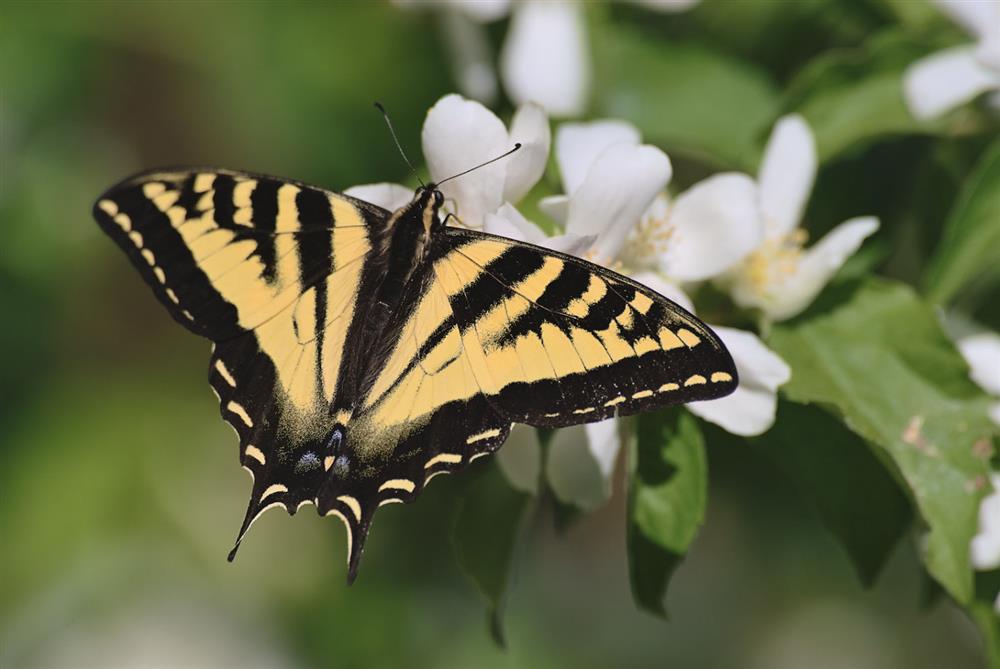
- Boys vs. Girls: Unlike their Eastern cousins, both sport bright yellow wings with black stripes and a hint of blue near the tail. The guys are just a bit more petite and agile.
- Home Turf: They own the West, from California to the Rocky Mountains, and even up into western Canada. They can also be found in parts of the Great Plains.
- Favorite Fuel: Lilacs, California buckeye, thistles—they're not picky about where they get their nectar.
- Egg Drop Spot: Cottonwoods, aspen, and willow are the top picks for egg-laying.
- Caterpillar Chow: Larvae feast on the leaves of these trees, with cottonwoods and willows being their faves.
- Behavior: Western Tigers are known for their "patrolling" behavior. Males fly along set routes in search of mates, often along streams or forest edges. They're also adept at avoiding predators with swift, zigzagging flight patterns.
- Habitat: Wooded areas, suburbs
- Flight Period:
- South: March–November (3 broods)
- North: June–July (1 brood)
- Winter Stage: Pupa
Pale Swallowtail (Papilio eurymedon)

- Boys vs. Girls: Cream-colored wings with black stripes. Males are smaller and speedier.
- Home Turf: They love the western U.S., especially the mountains from California to British Columbia.
- Habitat: Mountainous regions, coniferous and mixed woodlands, canyons
- Favorite Fuel: Thistles, dogbane, California buckeye—they're all on the nectar list.
- Egg Drop Spot: Shrubs and trees like buckthorn and wild cherry make the best cradles.
- Caterpillar Chow: The larvae keep it simple with buckthorn and wild cherry leaves. They also feed on other plants in the family Rosaceae, including Ceanothus and Rhamnus species.
- Behavior: Pale Swallowtails are hill-toppers, with males patrolling the highest points of hills and mountains to find mates. They're also known for their swift, erratic flight patterns, making them challenging for predators to catch.
- Flight Period: Lowlands:
- March to October (multiple broods)
- Mountains: June to August (typically one brood)
- Winter Stage: Chrysalis (pupa)
- Adult Food: Nectar from various flowers, including thistles, dogbane, and California buckeye. They also engage in puddling behavior.
Anise Swallowtail (Papilio zelicaon)
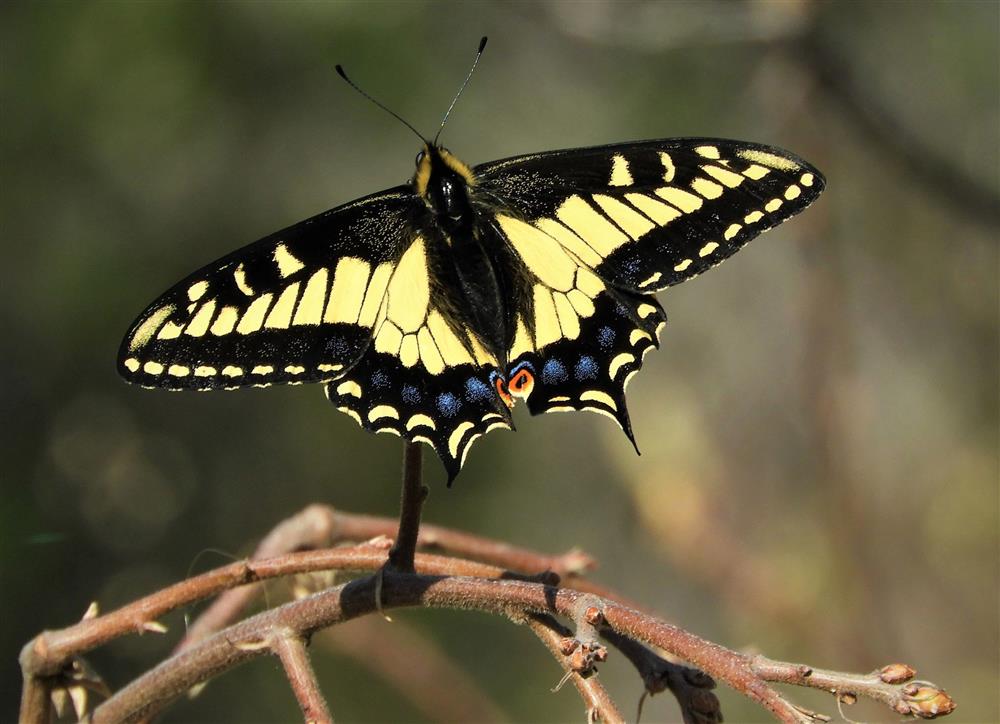
- Boys vs. Girls: Yellow wings with black stripes and blue spots. Females typically larger with more prominent markings.
- Home Turf: Western North America, from British Columbia to Baja California, eastward to the Rocky Mountains.
- Habitat: Open areas including fields, gardens, roadsides, coastal areas, and mountain meadows.
- Favorite Fuel: Adults enjoy nectar from a variety of flowers, particularly those in the family Asteraceae (daisies, thistles).
- Egg Drop Spot: Females lay eggs singly on host plants, sweet fennel, dill, parsley, anise, biscuit root, and citrus trees
- Caterpillar Chow: Larvae feed on plants in the carrot family (Apiaceae), including fennel, dill, parsley, and their namesake, anise.
- Behavior: Males exhibit territorial behavior, patrolling areas for females. They're known for their swift, erratic flight patterns.
- Flight Period: Lowlands:
- February to November (multiple broods)
- Mountains: May to August (typically one brood)
- Winter Stage: Chrysalis (pupa)
- Adult Food: Nectar from various flowers, particularly those in the Asteraceae family. They also engage in puddling behavior to obtain minerals.
- Special Note: The Anise Swallowtail is highly adaptable and has benefited from the introduction of non-native host plants like fennel in urban areas.
Swallowtails are among the most striking and diverse butterflies in North America. Each species has its unique characteristics, preferred habitats, host plants, and fascinating behaviors. From the Eastern Tiger's thermal soaring to the Zebra Swallowtail's rapid flight, and from the Black Swallowtail's mimicry to the Giant Swallowtail's chemical defenses, these butterflies showcase a range of intriguing adaptations. By planting their favorite nectar and host plants, you can attract these beautiful insects to your garden and contribute to their conservation. Understanding and appreciating the diversity of swallowtail butterflies enhances our connection to the natural world and highlights the importance of preserving their habitats.





























































































































































































































































































































































































































































































































































































































































